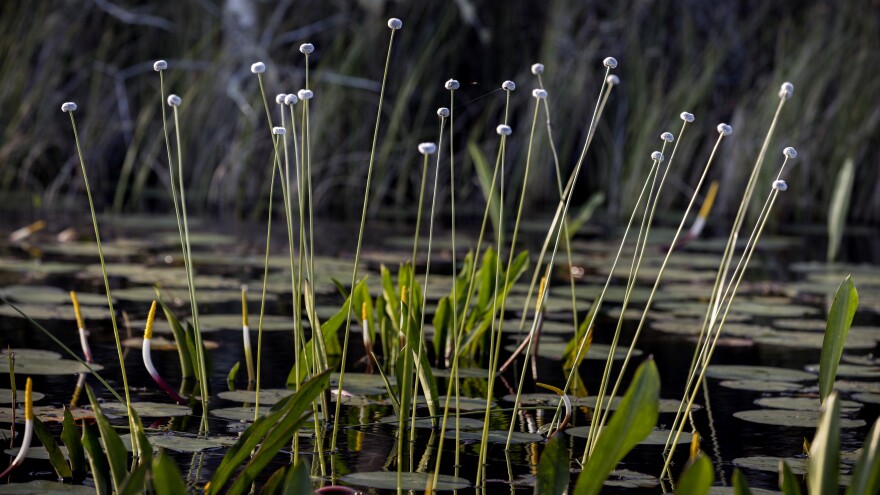Updated October 11, 2022 at 7:57 AM ET
The Pulitzer Prize-winning author Annie Proulx may be best known for her works of fiction, titles like The Shipping News and Brokeback Mountain.
But the 87-year-old author's newest book, Fen, Bog & Swamp: A Short History of Peatland Destruction and Its Role in the Climate Crisis, is a love letter to ecosystems that are rapidly disappearing — America's wetlands.
"Before the last wetlands disappear I wanted to know about this world we are losing," Proulx writes. "What was a world of fens, bogs and swamps and what meaning did these peatlands have, not only for humans but for all other life on Earth?"
In a conversation with Morning Edition's Leila Fadel, Proulx answers this question, describing the role of wetlands in preserving the environment and storing the carbon emissions that accelerate climate change.
But, Proulx says, this book is no call to arms. It is more a lesson in observation. Proulx wants her readers to understand better the world they live in and how to take care of it.
This interview has been edited for length and clarity.
Interview highlights
On what drew her to the subject of wetlands
It began when I found that I could not concentrate on writing fiction, which is what I am usually writing. I was too concerned with what was happening to the natural world, and I felt I knew very little about wetlands. The way I learn about something is to write about it. So I began reading and taking notes and scribbling, asking questions and after a while, I had something that looked like an essay and I sent it to my agent — not particularly expecting it to be published, but I thought it might have a place somewhere. To my surprise, she suggested that it could be a book.
On what she learned in her research on fens, bogs and swamps
We tend to tag everything in the natural world in terms of what use it is to humans. And I was curious to know how it fits in with the great scheme of life, how it belonged to other parts of the world, how land and water and creatures and weather and climate change were all knit together. So that was the thing. I wasn't looking for benefits to humans as an explanation of anything. I was looking for how these guys work with each other. But also, I was very curious about human responses to these wetlands. So that took me into the history. And that, of course, was the fun part. Poking around with the people of the fen, the battle in the bogs and the various swamps in North America that were drained and made into productive soil.

On the history of peatland destruction
The peatlands have never been regarded as something that's a necessary part of life, but as an obstruction, something that's in the way. The ideal, of course, is agriculture. For most people, it wasn't a measure of any kind of utility to talk about a peat-producing wetland as helpful. So it was really a change of attitude more than anything else that I stumbled on. It's really hard to read about this sort of thing because people insist on thinking of the natural world only in terms of utility to humanity. We don't see ourselves as part of this system, but as lords and rulers of the natural world.

On the vital purpose of wetlands
The problem with destroying the fens, bogs and swamps is they are holding in carbon dioxide and methane gas. And the more we rip them up, the more carbon dioxide and methane comes floating into the atmosphere and the faster the Earth will be warming. But that doesn't occur to us, to consider that a real problem, except for ecologists and those deeply concerned about the climate crisis.
On the exploitation of fens, bogs and swamps
We still do look at swamplands, bogs and fens as candidates for drainage. And I think there will forever be people who want to drain wetlands. They don't see how they could be useful. But there is a place for wetlands. Many gardeners buy bales of peat that have been dug up, dried and packaged, because it enriches their garden soil. Peat has the extraordinary ability to hold many times its weight in water. So it's a grand thing to put out in your garden.
On whether her book is a call to action
No, it isn't a call to action, but it's been mistaken as such. It is, simply, what it was for me:
That is, to know what the difference is between fen, bog and swamp. To be able to go into a wetland and look around at it and say, "Aha, I know this is a swamp, it's full of trees. Or, this is a bog, full of quaking sphagnum moss." It's more didactic than a call to arms. That's just not my thing.
This interview was conducted by Leila Fadel, produced by Julie Depenbrock and edited by Simone Popperl.
Copyright 2023 NPR. To see more, visit https://www.npr.org.


